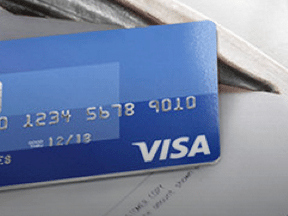Did you change credit card providers or renegotiate pricing with your existing provider in the last year? If so, did you verify that you were actually receiving the rates and fees you negotiated?
This is the second installment of a two-part series on confirming that your credit card processing rates are accurate. The first installment, “Check Credit Card Processing Rates before Holiday Rush,” we published last month.
Credit Card Processors Make Many Mistakes
I’ve mentioned the poor quality control in the credit card industry in past articles. In my experience, up to 25 percent of merchants are not receiving the pricing they negotiated because of errors on the application, order entry errors, or for other reasons. Earlier this year, more than 50 percent of the merchants I audited had pricing errors. Even worse, 100 percent of the errors forced the merchants to pay a higher cost.
… up to 25 percent of merchants are not receiving the pricing they negotiated because of errors on the application, order entry errors, or for other reasons.
This is very concerning, not only because of the high percentage of errors but also because all the errors favored the providers. One would expect some percentage of errors to favor merchants if the errors were truly random.
I had several conversations with merchants and their credit card salespeople on this issue. The results were eye opening. None of the salespeople I spoke with had ever completely read their own application and terms and conditions. Nor did they fully understand them.
Some of the salespeople couldn’t answer basic questions on provider fees versus card company fees. Some felt ill trained on completing their own merchant applications. Worst of all, in some cases, if the salesperson did not complete the application correctly, certain rates and fees would be set at the provider’s default settings, which were higher than the negotiated rates and fees in all cases.
Some of the errors I saw included:
- The American Express rate set at the provider’s default level of 3.50 percent, instead of the negotiated OptBlue rate;
- PIN debit markups at the provider’s default rate instead of the negotiated rate;
- Incorrect discount rates;
- Discover card monthly access fees, debit monthly access fees, and numerous other monthly fees that should not have been charged;
- The MC Acquiring License fee set at 0.41 percent instead of the provider’s actual rate of 0.0041 percent;
- Numerous per-transaction fees that should not have been charged. Some of the errors resulted in annual overcharges totaling several thousand dollars.
Maintain a Separate Document to Record Rates and Fees
Merchants should maintain a separate document in addition to the provider’s proposal and contract. The merchant’s document should list all negotiated provider rates and fees as well as the card companies’ pass-through rates and fees. The salesperson should agree to the rates and fees on the merchant’s document and confirm the same rates and fees on the provider’s contract before the merchant signs the contract.
After the merchant receives her first statement with the new rates and fees, she should verify with the salesperson each rate and fee on statement. The rate and fee comparison between the merchant’s document and statement should be exact. There should be not any rates and fees on the statement that were not on the merchant’s document. Some providers actually provide a detailed list of all pass-through fees on their proposal, which makes this process fairly easy.
After the merchant receives her first statement with the new rates and fees, she should sit down with the salesperson and verify each rate and fee on statement.
American Express OptBlue
Did your provider convert your account to the American Express OptBlue program over the last year or so?
I have received more calls from salespeople on the OptBlue program than from merchants. Some of the salespeople were panicking at the prospect of losing merchants because the merchants’ American Express cost had increased — not decreased — after they were placed on the OptBlue.
The American Express OptBlue pricing structure is far simpler than other card companies. Unfortunately, many providers have done a horrible job of educating their salespeople on the program and the actual rates and fees charged by American Express.
I’ve encountered a small number of merchants whose cost increased after being placed on the OptBlue program. If you are one of them, understand that it is your merchant account provider’s fault and not American Express. Any increase in cost is likely either a result of your provider’s desire to boost profit or its failure to determine the OptBlue impact on your existing cost.
OptBlue should significantly reduce the processing cost for most ecommerce and brick-and-mortar merchants. However, some industries, as such medical, already receive favorable pricing from American Express — so OptBlue may actually increase the processing cost in those cases. Other merchant types may not benefit from OptBlue pricing as well because of their pricing structure. However, American Express has communicated these nuances to the providers.
What I find most concerning, however, about the OptBlue program is the high number of merchants that have been automatically converted to OptBlue by their provider and the provider has kept all or most of the cost savings.
What I find most concerning, however, about the OptBlue program is the high number of merchants that have been automatically converted to OptBlue by their provider and the provider has kept all or most of the cost savings.
For example, a small ecommerce merchant that is not on OptBlue typically pays 3.50% + $0.00 to American Express on a $50 sale. For OptBlue, barring any international or special issue fees, American Express charges the provider wholesales rates and pass-through fees of 2.15% + $0.10 to 2.45% + $0.10 on the same $50 sale. This wholesale cost is even lower for brick and mortar merchants. The provider then adds its mark-up on to the wholesale cost.
If your provider automatically converted your business to OptBlue, did it pass along the savings or are you still being charged a pre-OptBlue rate of 3.50 percent for ecommerce?
Even if the provider is charging through the correct wholesale and pass-through fees, is the provider applying the same mark-up — say, 0.10% + $0.10 — for American Express as it is with Visa and MasterCard?
American Express OptBlue is a very good program for most merchants. However, read my 3-part series from 2014 on OptBlue and use my PDF “American Express Pricing Checklist” to ensure your prices are correct.
The OptBlue program is a test of a provider’s integrity and its desire to help its merchant customers. Take action if your provider (a) didn’t pass along the OptBlue savings, (b) is charging a higher mark-up than for Visa and MasterCard, or, even worse, (c) is causing your processing cost to increase. Decide if you want to renegotiate with that provider or find one that cares more about your business.




